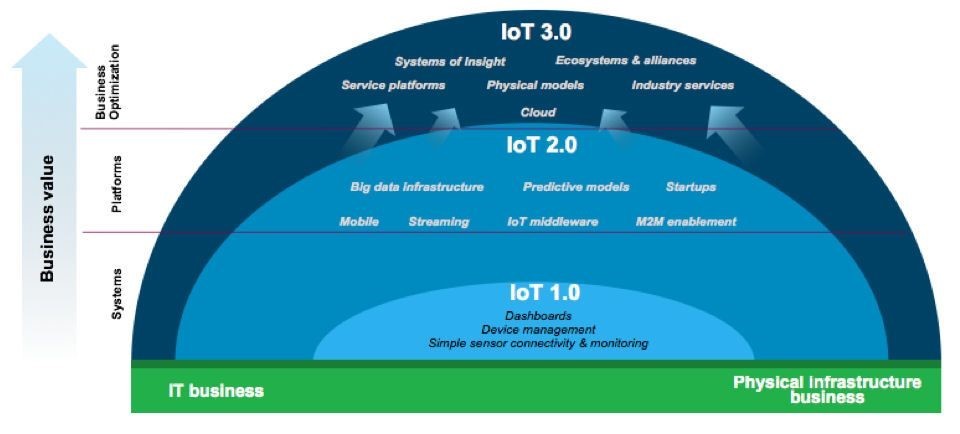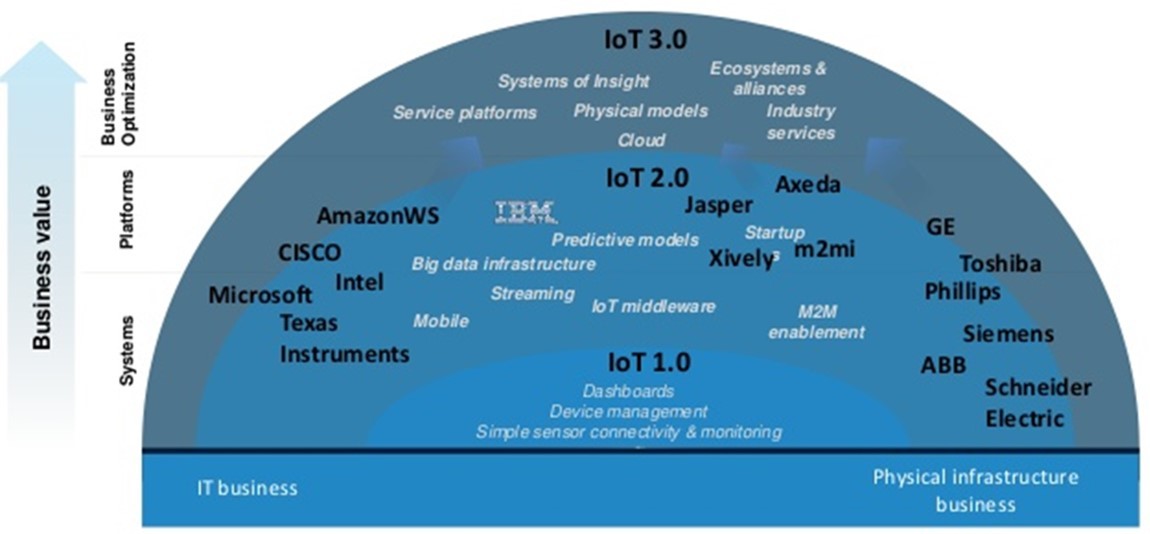I have not intended to abuse of one more time of a shocking headline in IoT but the fact is that per Gartner´s 2016 Hype Curve” the Internet of Things (IoT) had falling into the dreaded Trough of Disillusionment and the Powerful analyst firm decided to not mention IoT anymore in 2017. Also, corroborated for many pessimistic articles of IoT project failures .
So it is our responsibility as IoT influencers to continue evangelizing about how the “The Internet of Things will Change our World”.
In the article “The Internet of Things… Are We There Yet?” , Cees Links points out that “The IoT is suffering today from a lack of understanding of its true value proposition and even if we are currently in the Valley of Disillusionment, we should not be distracted. We still have a lot to learn but we are in the middle of shaping a better world for the next generation”.
IoT 1.0 or the time of the Systems
It seems prehistoric. I'm talking about the world of Telemetry, Machine to Machine, Industrial Control Systems (PLCs, SCADAs, HMI,..) . But IoT 1.0 is still the one that holds the largest number of devices connected so far. Simple solutions for departmental, very controlled business needs, designed without security as a priority and not easy to integrate and of course with the objective of create new business models.
One interesting outgrowth was the emergence of the “IoT engineer” version 1.0. This was an embedded engineer, cloud SW developer, mobile app developer, or networking specialist that has gained knowledge and skills in one or more of the other disciplines within IoT.
IoT 2.0 or the time of the Platforms
Scott Nelson and Paul Metaxatos published an article in Harvard Business Review on the importance of design in creating value in the next phase of the Internet of things (IoT). IoT 2.0 was the natural next step in the technology adoption curve and brought in a new wave of IoT-facilitated solutions that still have not demonstrated a higher rate of adoption and return on investment.
Many companies have been able to check during the last three years that IoT projects are complex and adoption of the technology can be harder because of the lack of standards, security issues and competitive and fragmented nature of the IoT ecosystem.
See below a list of characteristics and judge yourself what still missing to overcome IoT2.0:
- Standards are respected
- Separation of content and design
- Machine Content syndication
- A simple programming language for non-intelligent machines
- A programming language for intelligent machines
- Network of Social Machines
- Machines responsible for the management and security of its information
- Hierarchy of Machines (APIs)
- Search Engine - Facilitate positioning with specific URLs for machines
In Design Elements for the Internet of Things 2.0 you will find some design elements that had been introduced to actually make things intelligent and not just “Smart.”
But above all, the IoT 2.0 has been a mediatic pulse between IoT Platforms and Artificial Intelligence.
New breed of IoT 2.0 engineers, vendors, product managers, developers, analysts,… are stripping the daisy. Take a look at “IoT Generalist vs IoT Specialist, Who will survive to the era of Robots? “ if you did not read yet.
IoT 3.0 or the time of Business Optimization
In Salesforce blog, we can find some of the IoT 1.0 and 2.0 limitations. The writer of the article indicates: “Much of the IoT technology available today does not make it easy to add value or generate ROI. To date, most IoT technology has been focused on networking devices together (IoT 1.0) or analyzing data that is streaming from those networked devices (IoT 2.0).
Both IoT 1.0 and IoT 2.0 are critical for a business to succeed in the connected world, because they provide the foundational layer for how a business collects and analyze their data. However, to provide true returns on IoT investment you have to be able to connect all of those analyzed and networked devices back to business value. “
For Salesforce obviously, the IoT 3.0 - is related with “The connected customer experience. But the focus on almost every company working with IoT today is how its use IoT data to improve business processes or change business models.
By enriching device/objects data in near real time with context data, companies have a very powerful set of data from which they can build business rules to generate actions and measurable outcomes. Many examples of highly interesting rules could be created with this new rich data set.
Also in “Internet of Things 3.0 scaled by Robotic Process Automation (RPA)” the author explain how The Internet of Things and RPA can function together and examine the ways in which RPA and the Internet of Things can foster collaborative, efficient business processes.
IoT 3.0 is the bridge from things to humans, whether they be your customers, partners, suppliers, or employees to drive measurable outcomes and ROI.
IoT 4.0 or the time of the Social IoT
We have seen how the different stages of IoT have been providing an increasing degree of intelligence to the machines. The technology allowed move enterprises from an experience that consisted of a simple monitoring and remote control of machines to an integration of the outcomes of these machines into enterprise processes that has allow create new business models.
IoT 4.0, which is already emerging, will add machine learning and artificial capabilities to the value chain to make experiences truly seamless and part of everyday life.
The sheer volume of data from IOT 3.0 will be a rich source to really power IoT 4.0, using AI to make the connected chain truly intelligent.
Most of the robots, machines, equipment, devices and countless objects that have been designed, built and sold to the heat of the IoT have focused the functional and technical requirements in reducing the costs of connectivity, increase battery life, provide end security (here not so much) and usability, but not in the capacity of self-learning or provide artificial intelligence.
But this time will be soon over, and intelligent machines (I am not thinking in 50 billion simple devices) but millions of let call by now “Any kind of purpose Robots or AKPR“ will be a reality, And these AKP Robots will need their own social networks.
The fear of intelligent machines persists in our collective memory and companies like Facebook forced to shut down it AI project after it invents its own language they couldn’t understand.! But we can not stop evolution and AKPR Robots are the next step in the evolution of Industrial or home robots.
I'm not the only one thinking about social machines. The Social Internet of Things (SIoT) organization has defined SIOT as an IoT where things are capable of establishing social relationships with other objects, autonomously with respect to humans.
The objectives being pursued by the Social Internet of Things (SIoT) paradigm are clear: to keep separate the two levels of people and things; to allow objects to have their own social networks; to allow humans to impose rules to protect their privacy and only access the result of autonomous inter-object interactions occurring on the objects’ social network.
In their vision, smart objects (even though extremely intelligent) will not make a difference, but social objects will make it!
Only when we decide to turn Smart Objects into Social Objects the Internet of Things will boost its economic and social value
The Internet of Things IoT 4.0 or Social Internet of Things need agnostic networks and protocols that guarantee performance, scalability or security. The Social Objects must be able to interoperate among the IoT Cloud Platforms.
There is no doubt that many applications and services should in the future be associated with groups of objects, whose individuality will be 'sacrificed' to the overall interest of providing services to users.
We need to think in new scenarios where interactions among social objects assume the shape of social interactions that mimic the four "elementary relational models" observed in human behaviour.
It will not be easy to reach the IoT 4.0 level. The interests of corporations, governments inefficiencies, lack of citizen preparation and other short-term factors to which our society is subjected will delay the adoption of the Social Internet of Things.
Key Takeaways
We are very far of IoT 4.0. Today most objects are unconnected, only a few connected objects are intelligent, enterprises continue working on silos, governments services are inefficient, interoperability is a chimera, robots do not have their protocols and social networks, humans are still limiting the promises of IoT.
The Internet of Things promises to be a source of great benefits to our lives but it will definitely take more time than expected.
Only when we decide to turn Smart Objects into Social Objects the Internet of Things will boost its economic and social value.



[…] When I finished my studies in Physics I had doubts about how I should guide my professional career. Two areas interested me about the rest: Telecommunications and Artificial Intelligence (AI). I chose the first for purely monetary short-term reasons. But I never leaved the second, and finally now, more than 20 years later I have the opportunity of work with the two thanks to the Internet of Things 4.0. […]